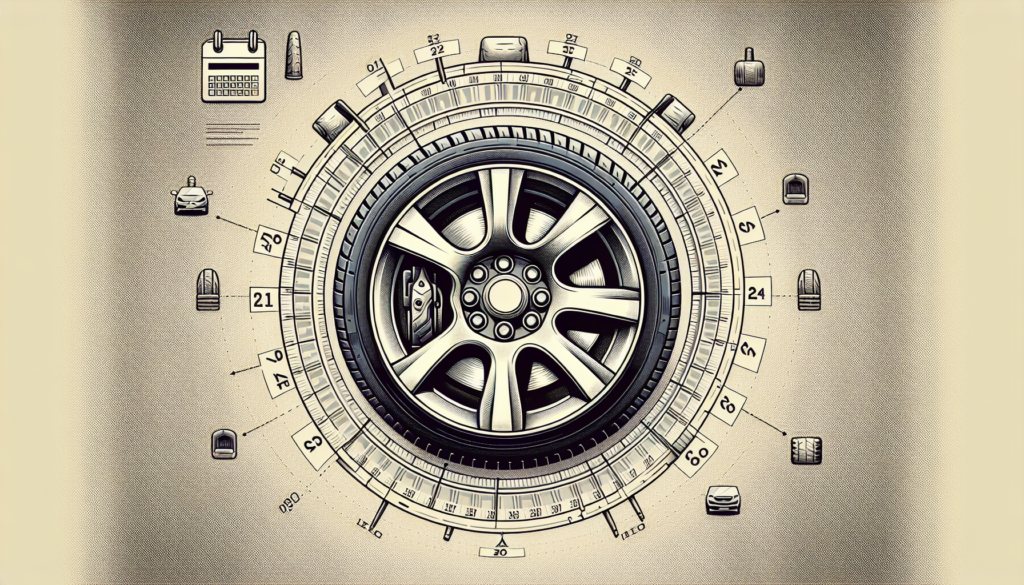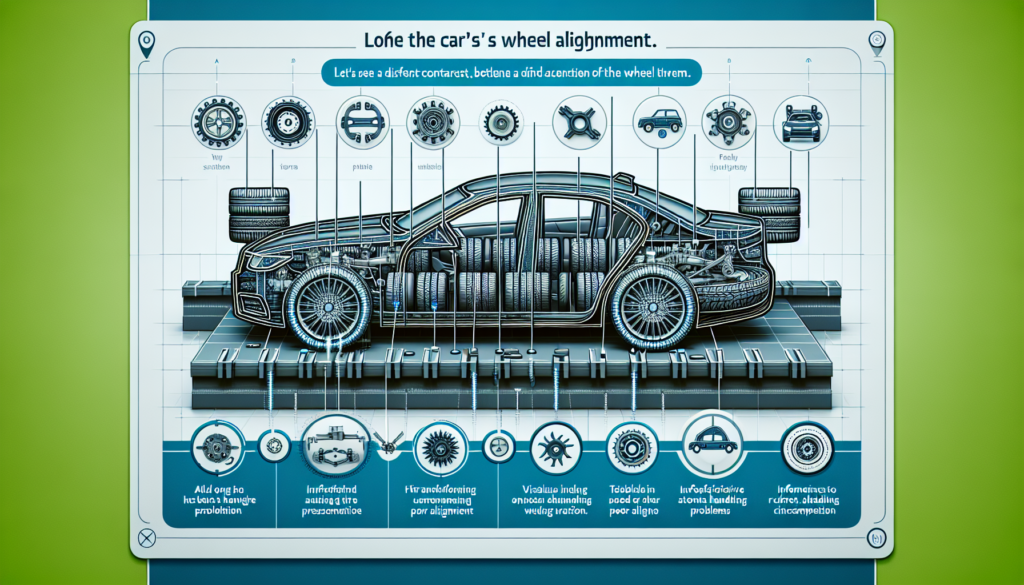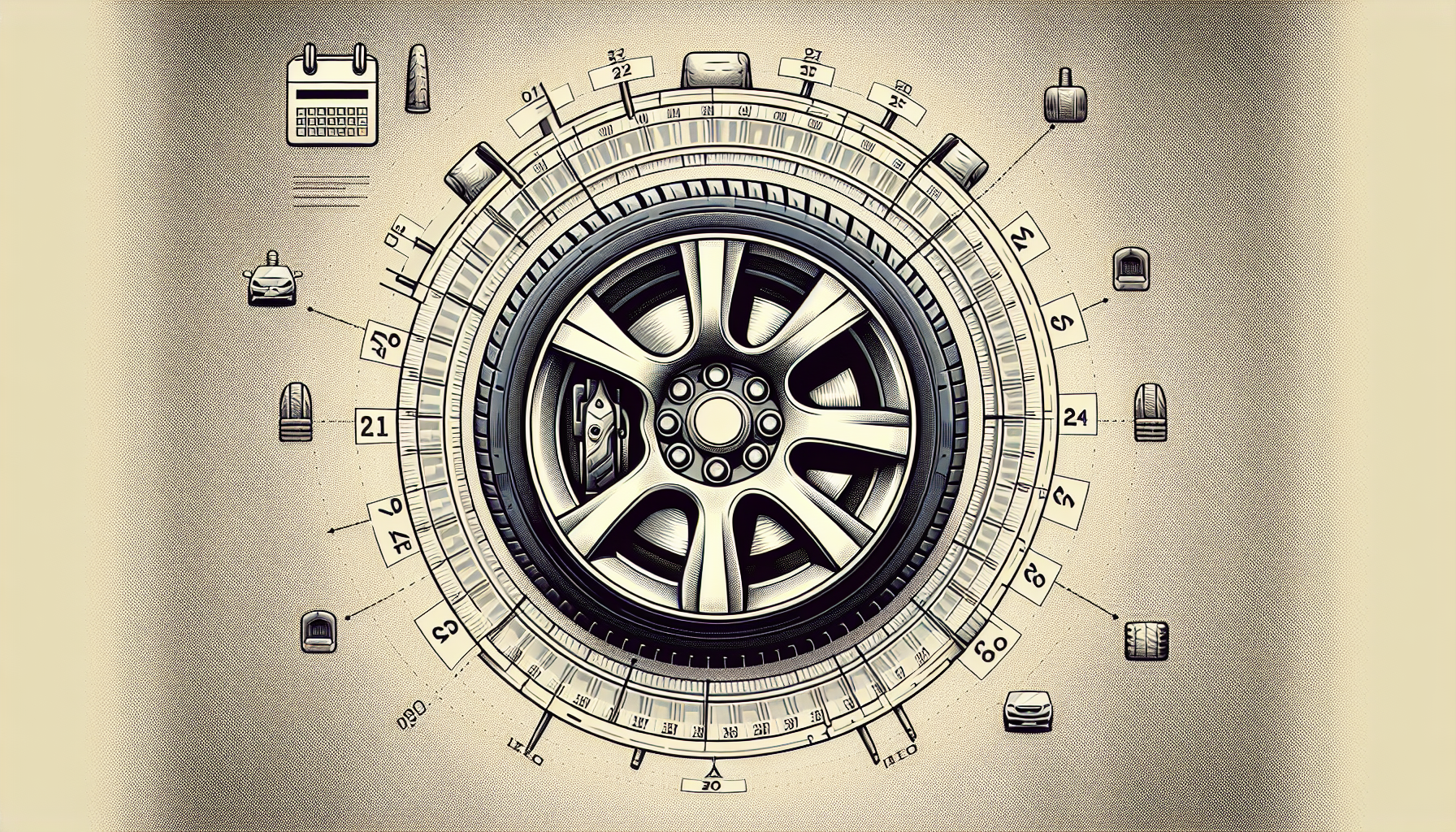If you’ve ever experienced your vehicle pulling to one side, uneven tire wear, or a vibrating steering wheel, then it might be time to consider getting a wheel alignment. A wheel alignment ensures that your tires are properly aligned with each other and the road, improving the overall performance and safety of your vehicle. In this article, we will explore some common signs that indicate your vehicle may be in need of a wheel alignment, helping you to make a more informed decision about maintaining your car’s optimal performance.

Signs of Wheel Alignment Issues
Uneven tire wear
One of the most common signs of wheel alignment issues is uneven tire wear. If you notice that one side of your tires is more worn out than the other, it could indicate that your wheels are not properly aligned. Uneven tire wear can occur due to the improper distribution of weight on the tires, causing them to wear out more quickly on certain areas.
Vehicle pulling to one side
Another sign of wheel alignment issues is when your vehicle pulls to one side while driving. If you find yourself constantly adjusting the steering wheel to keep your vehicle going straight, it may be a clear indication of misaligned wheels. When the wheels are not properly aligned, uneven friction can occur on the tires, causing the vehicle to pull to one side.
Crooked steering wheel
If you notice that your steering wheel is not centered and is slightly tilted to one side when driving straight, it may indicate a wheel alignment problem. A crooked steering wheel is a clear indication that the wheels are not aligned properly and may need to be adjusted.
Vibrations in the steering wheel
Experiencing vibrations in the steering wheel while driving can be another sign of wheel alignment issues. Misaligned wheels can cause uneven tire wear, resulting in vibrations that can be felt through the steering wheel. If you notice these vibrations, it is essential to have your wheel alignment checked.
Squealing tires
When you hear your tires squealing, it may be a sign that your wheels are misaligned. Misaligned wheels can cause excessive tire scrubbing, leading to tire squealing when turning corners or even during straight-line driving. If you notice this squealing noise, it is important to have your wheel alignment checked to prevent further damage to your tires.
Poor steering response
If your vehicle’s steering feels loose or unresponsive, it could be a result of wheel alignment issues. When the wheels are not properly aligned, it can affect the responsiveness and control of your steering. Poor steering response can make it more difficult to navigate corners and maintain control of the vehicle.
Off-center steering wheel
An off-center steering wheel is another sign of wheel alignment problems. When the wheels are not aligned, it can cause the steering wheel to be off-center when driving straight. This misalignment can be visually noticeable, and it is important to have it corrected to ensure proper wheel alignment.
Excessive tire wear
Excessive tire wear is a clear indication of wheel alignment issues. Misaligned wheels can lead to uneven tire wear, causing the tires to wear out more quickly. If you notice significant wear on the inner or outer edges of your tires, it is essential to have your wheel alignment checked and corrected to prevent premature tire replacement.
Sudden changes in fuel efficiency
If you notice a sudden decrease in fuel efficiency, it may be a result of wheel alignment problems. Misaligned wheels can create excessive friction and resistance, causing the engine to work harder and burn more fuel. If you notice a significant change in your vehicle’s fuel efficiency, it is worth having your wheel alignment checked to ensure optimal performance.
Changes in vehicle handling
When your vehicle’s handling feels different, such as increased difficulty in maneuvering or a lack of stability, it could be a result of wheel alignment issues. Misaligned wheels can affect the overall balance and stability of the vehicle, making it more challenging to control. If you experience any changes in your vehicle’s handling, it is crucial to have your wheel alignment checked to ensure safe driving conditions.
Reasons Behind Wheel Alignment Problems
Hitting potholes or curbs
One of the common causes of wheel alignment problems is hitting potholes or curbs. These impacts can cause sudden jolts to the wheels, leading to misalignment. When the wheels hit a pothole or curb, it is important to have the wheel alignment checked, as even minor impacts can disrupt the alignment.
Driving on rough roads
Frequent driving on rough or uneven roads can also contribute to wheel alignment issues. Rough roads with uneven surfaces can cause the wheels to be jarred out of alignment over time. It is important to have regular wheel alignment checks if you frequently drive on roads with poor conditions.
Worn suspension components
Worn suspension components, such as springs, shocks, or struts, can also lead to wheel alignment problems. When these components wear out, they can no longer provide the necessary support and stability to keep the wheels properly aligned. Regular inspection and maintenance of suspension components can help prevent alignment issues.
Accidents or collisions
Accidents or collisions can result in significant damage to the vehicle, including the alignment of the wheels. The impact from an accident can knock the wheels out of alignment, requiring adjustments or repairs. After any accident or collision, it is essential to have the wheel alignment checked to ensure safe and proper alignment.
Improper installation of suspension parts
If suspension parts, such as control arms or tie rods, are improperly installed during repairs or modifications, it can lead to wheel alignment problems. Proper installation of suspension components is crucial to maintaining proper wheel alignment. It is important to have any suspension work done by a certified technician to avoid alignment issues.
Worn-out steering components
Worn-out steering components can contribute to wheel alignment problems. Components such as steering linkage or ball joints can wear out over time, leading to instability and misalignment. Regular inspection and maintenance of steering components can help prevent alignment issues.
Neglecting regular maintenance
Neglecting regular maintenance, including wheel alignments, can also lead to alignment problems. Over time, the wheels can gradually shift out of alignment due to factors such as normal wear and tear, driving conditions, and temperature changes. Regular wheel alignment checks and adjustments are essential to maintaining proper alignment.
Misalignment during tire replacement
Improper alignment can occur during the replacement of tires if the technician fails to properly align the wheels after installation. It is important to ensure that the wheels are correctly aligned after the installation of new tires to avoid alignment issues.
Excessive wear of tires
Excessive tire wear can contribute to wheel alignment problems. When the tires are worn unevenly or have significant tread wear, it can affect the alignment of the wheels. Regular tire maintenance, including rotations and replacements, can help prevent excessive wear and minimize alignment issues.
Driving long distances
Driving long distances can also lead to wheel alignment problems. Frequent and prolonged driving can cause the wheels to gradually shift out of alignment. Regular wheel alignment checks are especially important for those who frequently drive long distances.
Methods to Check for Wheel Alignment Issues
Visual inspection
A visual inspection can be the first step in checking for wheel alignment issues. Look for signs of uneven tire wear, such as worn edges or bald spots, and check if the steering wheel is centered when driving straight. Additionally, visually inspect the suspension components for signs of damage or wear.
Testing vehicle pulling
To test if your vehicle is pulling to one side, find a straight and level road. Take your hands off the steering wheel briefly and observe if the vehicle veers to one side. If it does, this can be an indication of wheel alignment problems.
Checking tire wear patterns
Inspecting tire wear patterns can give you clues about your wheel alignment. Check for signs of uneven wear, such as more wear on the inner or outer edges of the tires. If you notice significant variations in wear patterns across the tires, it may indicate misalignment.
Using alignment equipment
Professional alignment equipment can help accurately measure and diagnose wheel alignment issues. This involves using specialized tools and equipment to assess the angles and positions of the wheels. Alignment equipment provides precise measurements and is the most accurate way to check for wheel alignment problems.
Measuring camber, toe, and caster angles
Using alignment equipment, certified technicians can measure the camber, toe, and caster angles of the wheels. These measurements help diagnose misalignment and determine the adjustments needed to correct the alignment.
Examining suspension and steering components
During a wheel alignment check, it is important to inspect suspension and steering components for any damage or wear. Worn or damaged components can contribute to wheel alignment issues and may need to be repaired or replaced.
Testing wheelbase and track width
The wheelbase and track width measurements can provide additional information about possible alignment issues. A wheelbase measurement compares the distance between the front and rear axles, while track width measures the distance between the left and right wheels. Any discrepancies in these measurements can indicate misalignment.
Performing road test
A road test can help identify wheel alignment issues by observing how the vehicle handles and steers. During the road test, pay attention to any pulling, vibrations, or changes in steering response. These observations can help determine if further alignment adjustments are needed.
Inspecting for vibrations
Inspecting for vibrations in the steering wheel or vehicle can indicate wheel alignment problems. Vibrations can be a result of uneven tire wear or misaligned wheels. If you experience vibrations, it is important to have your wheel alignment checked to prevent further damage.
Analyzing fuel efficiency
Monitoring changes in fuel efficiency can also be a method to check for wheel alignment issues. Misaligned wheels can cause increased resistance and friction, leading to decreased fuel efficiency. If you notice a sudden decrease in fuel efficiency, it may indicate the need for a wheel alignment check.
Effects of Wheel Misalignment
Uneven tire wear
One of the most significant effects of wheel misalignment is uneven tire wear. When the wheels are not properly aligned, certain areas of the tires may experience increased friction, causing uneven wear. Uneven tire wear can lead to premature tire replacement and decreased overall tire lifespan.
Reduced fuel efficiency
Wheel misalignment can also result in reduced fuel efficiency. Misaligned wheels create additional resistance and force the engine to work harder, decreasing fuel efficiency. An aligned set of wheels can help minimize friction and improve fuel efficiency, saving you money at the gas pump.
Decreased tire lifespan
Misaligned wheels can cause excessive tire wear, leading to a decreased lifespan for your tires. When the tires wear unevenly due to misalignment, they may need to be replaced sooner than expected. Regular wheel alignments can help extend the lifespan of your tires and save you money in the long run.
Unsafe driving conditions
Driving with misaligned wheels can create unsafe conditions on the road. Misalignment can affect the vehicle’s handling, stability, and control, making it more difficult to respond to sudden maneuvers or maintain control during emergency situations. Proper wheel alignment is vital for safe driving.
Increased stress on suspension parts
Wheel misalignment can place additional stress on suspension components. When the wheels are not properly aligned, certain suspension parts, such as springs, shocks, and struts, may bear excessive loads. Over time, this increased stress can lead to premature wear and failure of these components.
Impaired handling and safety
Misaligned wheels can result in impaired handling and compromised safety. They can cause the vehicle to pull to one side, affecting steering control and making it more difficult to maintain stability. Proper wheel alignment is crucial for safe and precise handling, especially during cornering and braking.
Worsening of ride comfort
Driving with misaligned wheels can lead to a worsening of ride comfort. Misalignment can create vibrations and uneven tire wear, causing a bumpy and uncomfortable ride. Proper wheel alignment can help improve ride comfort by minimizing these issues.
Inaccurate vehicle geometry
Wheel misalignment can affect the overall geometry of the vehicle. When the wheels are not aligned correctly, it can alter the angles and positions of various components, such as the suspension and steering. This can result in an inaccurate vehicle geometry, which can impact overall performance and safety.
Costly repairs in the long run
Neglecting wheel alignment issues can lead to costly repairs in the long run. Misalignment can cause excessive tire wear, premature suspension component failure, and other related issues. Regular wheel alignments can help detect and correct alignment problems early, potentially saving you from more expensive repairs down the line.
Compromised braking performance
Misaligned wheels can also compromise the braking performance of your vehicle. Unevenly distributed braking forces due to misalignment can lead to longer stopping distances and decreased overall braking effectiveness. Maintaining proper wheel alignment is crucial for optimal braking performance and safety.

Importance of Regular Wheel Alignments
Improved safety
Regular wheel alignments are essential for improved safety on the road. Properly aligned wheels ensure precise steering control, stability, and responsiveness, reducing the risk of accidents and collisions. By maintaining proper wheel alignment, you can enjoy a safer driving experience for yourself and other road users.
Enhanced fuel efficiency
Proper wheel alignment contributes to enhanced fuel efficiency. Aligned wheels minimize unnecessary resistance and friction, reducing the workload of the engine and improving overall fuel economy. Regular wheel alignments can help you save money at the pump by maximizing fuel efficiency.
Extended tire lifespan
Regular wheel alignments help extend the lifespan of your tires. Proper wheel alignment ensures even distribution of weight and forces on the tires, preventing uneven wear and premature tire replacement. By maintaining optimal wheel alignment, you can extend the longevity of your tires and save money on replacements.
Optimal vehicle performance
Proper wheel alignment is crucial for optimal vehicle performance. Aligned wheels provide better handling, stability, and control, enhancing the overall performance of your vehicle. By maintaining proper wheel alignment, you can enjoy a smoother and more enjoyable driving experience.
Prevention of premature tire wear
Regular wheel alignments prevent premature tire wear by ensuring even contact between the tires and the road surface. Proper alignment minimizes stress and friction on the tires, helping to maintain their tread life. By preventing premature tire wear, you can save money by avoiding the need for frequent tire replacements.
Reduced strain on suspension system
Wheel misalignment places additional strain on the suspension system. By having regular wheel alignments, you can help reduce the strain on suspension components such as springs, shocks, and struts. This can prevent premature wear and failure of these parts, ensuring a smoother and more comfortable ride.
Promotion of even tire wear
Proper wheel alignment promotes even tire wear across all four tires. Even wear patterns help maintain the optimal performance and handling of the tires. Regular wheel alignments ensure that the tires wear evenly, extending their lifespan and improving their overall performance.
Better handling and maneuverability
Proper wheel alignment contributes to better handling and maneuverability of your vehicle. Aligned wheels provide optimal stability, control, and responsiveness, allowing for smoother steering, cornering, and braking. By maintaining proper wheel alignment, you can enjoy better control and confidence on the road.
Mitigation of potential accidents
Regular wheel alignments help mitigate potential accidents by ensuring proper handling and stability of your vehicle. Aligned wheels reduce the risk of sudden veering, uneven tire wear, and compromised braking performance, minimizing the chances of accidents and improving overall road safety.
Cost-effective maintenance
Regular wheel alignments are a cost-effective way to maintain your vehicle’s performance and safety. By addressing alignment issues early on, you can prevent more expensive repairs and replacements in the future. Proper wheel alignment helps extend the lifespan of your tires and other components, saving you money in the long run.
Frequency of Wheel Alignment Checks
As part of regular maintenance
Including wheel alignment checks as part of your regular vehicle maintenance routine is essential. It is recommended to have your wheel alignment checked at regular intervals, even if you are not experiencing any noticeable issues. This proactive approach can help detect and correct alignment problems before they worsen.
After hitting a pothole or curb
After hitting a pothole or curb, it is crucial to have your wheel alignment checked. These impacts can easily knock the wheels out of alignment, leading to safety and performance issues. Even if you do not notice any immediate problems, it is still advisable to have the alignment checked to prevent any potential issues from developing.
After collisions or accidents
After any collision or accident, it is necessary to have your wheel alignment checked. The impact from the collision can cause significant damage to the wheels and suspension components, affecting the alignment. It is important to have a professional inspection to ensure proper alignment and address any alignment issues resulting from the accident.
When experiencing driving-related issues
If you experience any driving-related issues such as pulling, vibrations, or changes in steering responsiveness, it is essential to have your wheel alignment checked. These issues can be indications of misaligned wheels, which should be addressed promptly to ensure safe driving conditions.
When replacing tires
When replacing tires, it is recommended to also have the wheel alignment checked. Proper alignment is crucial for even wear patterns and to maximize the lifespan of the new tires. Having the alignment checked during tire replacement can help ensure optimal performance and longevity of the tires.
Every 6,000 to 10,000 miles
On average, it is recommended to have your wheel alignment checked every 6,000 to 10,000 miles. This mileage range serves as a general guideline and can vary depending on your driving habits, road conditions, and the recommendations of your vehicle manufacturer. Regular checks can help detect and address alignment issues in a timely manner.
At least once a year
Even if you do not exceed the mileage range mentioned above, it is advisable to have your wheel alignment checked at least once a year. This regular interval can help detect any gradual misalignment that may have occurred over time. By having the alignment checked annually, you can ensure the ongoing safety and performance of your vehicle.
As advised by the vehicle manufacturer
It is always important to refer to the recommendations of your vehicle manufacturer regarding wheel alignment checks. Manufacturers may provide specific guidelines and intervals for alignment checks based on the make and model of your vehicle. Following these recommendations can help maintain optimal alignment and prevent any warranty issues.
When noticing abnormal tire wear
If you notice abnormal tire wear, such as excessive wear on one side or unusual patterns, it is crucial to have your wheel alignment checked immediately. Abnormal tire wear can indicate misalignment or other underlying issues that need to be addressed promptly to prevent further damage to the tires.
When modifications are made to suspension system
If you make any modifications or alterations to your vehicle’s suspension system, such as installing new springs or modifying the ride height, it is important to have your wheel alignment checked. These modifications can affect the alignment, and adjustments may be needed to ensure proper alignment.

Professional Wheel Alignment Services
Certified technicians
Professional wheel alignment services are performed by certified technicians who have the knowledge and expertise to accurately diagnose and correct alignment issues. Certified technicians are trained to use specialized equipment and follow industry standards to ensure precise and proper alignment.
State-of-the-art equipment
Professional wheel alignment services utilize state-of-the-art equipment to measure and adjust the alignment of your wheels. These advanced tools provide accurate measurements and precise adjustments, ensuring optimal alignment and performance.
Computerized alignment systems
Computerized alignment systems are used by professional alignment services to further enhance accuracy and efficiency. These systems use advanced technology to analyze alignment measurements and make precise adjustments based on manufacturer specifications.
Evaluation of suspension and steering
During a professional wheel alignment service, the suspension and steering components are thoroughly evaluated. Certified technicians inspect these components for any damage, wear, or alignment-related issues. Any necessary repairs or replacements can be recommended and addressed.
Adjustment of camber, caster, and toe angles
Professional wheel alignment services include adjustments of the camber, caster, and toe angles of the wheels. These adjustments ensure that the wheels are aligned according to the manufacturer’s specifications, optimizing vehicle performance and tire wear.
Precise measurements and alignments
Professional alignment services provide precise measurements and alignments using specialized equipment. Certified technicians accurately measure the angles and positions of the wheels to identify any misalignment. Based on these measurements, they make the necessary adjustments to achieve proper alignment.
Recommendations for additional repairs
During a professional wheel alignment service, certified technicians may identify additional repairs or maintenance needs. This can include suspension or steering component replacements, tire rotations, or wheel balancing. Recommendations for these additional services can help optimize the performance and safety of your vehicle.
Proper documentation of alignment results
Professional wheel alignment services provide proper documentation of the alignment results. This includes detailed records of the before and after measurements, adjustments made, and any additional recommendations. Having this documentation can be helpful for future reference and warranty purposes.
Quality assurance and warranty
Professional wheel alignment services often come with quality assurance and warranty. These services stand behind their work, ensuring customer satisfaction and providing warranties for their alignment services. This gives you peace of mind knowing that the alignment was performed correctly and that any issues will be addressed.
Post-alignment road test
After the alignment adjustments are made, professional alignment services typically perform a post-alignment road test. This test allows the certified technicians to ensure that the vehicle handles and performs properly after the alignment. It provides an additional level of quality control to ensure the accuracy of the alignment.
DIY Wheel Alignment Methods
String method
The string method is a basic DIY wheel alignment method that can be used to check the toe alignment of the wheels. It involves using a simple string or fishing line to compare the position of the tires on the front and rear axles. By adjusting the steering and measuring the distance between the tires and the string, you can determine if the wheels are properly aligned.
Thrifty angle method
The thrifty angle method is another DIY approach to check the camber and caster angles of the wheels. It requires a protractor or angle finder tool to measure the angles of the wheels and compare them to the manufacturer’s specifications. The method involves aligning the tool with the wheel angles and making adjustments as needed.
Jack stand method
The jack stand method is a DIY wheel alignment method that allows you to check the toe alignment of the wheels. It requires lifting the vehicle with jack stands and using a measuring tape or ruler to compare the distances between the front and rear edges of the tires. By adjusting the tie rods, you can achieve the proper toe alignment.
Using alignment tools
Alignment tools, such as toe plates or camber gauges, can be used for DIY wheel alignment. These tools provide more accurate measurements and ease of use compared to basic DIY methods. They typically require positioning the tools against the wheels and reading the measurements to determine if adjustments are needed.
Do-it-yourself alignment kits
Do-it-yourself alignment kits are available for those who want to perform more advanced wheel alignments at home. These kits often include specialized tools, instructions, and guidelines to help you properly measure and adjust the alignment angles of your wheels. It is important to follow the instructions carefully and ensure that you have the necessary knowledge and experience to perform the alignment correctly.
Following manufacturer guidelines
When attempting a DIY wheel alignment, it is important to refer to the manufacturer’s guidelines for your specific vehicle. Each make and model may have different alignment specifications, and it is important to align your wheels according to these specifications. Following the manufacturer’s guidelines helps ensure proper alignment and optimal performance.
Measuring alignment angles
Measuring the alignment angles using a protractor, angle finder, or alignment tools is an essential part of DIY wheel alignment. The angles to measure typically include camber, caster, and toe, which can vary depending on the vehicle. Accurate measurements are crucial to determining the misalignment and making the necessary adjustments.
Adjusting tie rods and control arms
DIY wheel alignment often involves adjusting the tie rods and control arms to correct the alignment angles. These adjustments can be made by turning the adjuster nuts or bolts to lengthen or shorten the tie rods or control arms. It is important to consult the manufacturer’s guidelines and use proper techniques when making these adjustments.
Using turn plates or alignment bars
Turn plates or alignment bars can be used for DIY wheel alignment to help measure the toe angle of the wheels. These tools allow the wheels to rotate while the measurements are taken, providing more accurate readings. Turn plates or alignment bars are positioned under the tires, and the toe measurements can be read using a measuring tape or ruler.
Repeating the alignment process
After making initial adjustments to the alignment angles, it is important to repeat the alignment process. This helps ensure that the adjustments were made correctly and that the wheels are now properly aligned. Repeating the alignment process allows you to fine-tune the adjustments and achieve optimal alignment.

When to Seek Professional Alignment Assistance
Lack of necessary tools and equipment
If you do not have the necessary tools and equipment for a DIY wheel alignment, it is best to seek professional assistance. Professional alignment services have specialized tools and equipment specifically designed for accurate measurements and precise adjustments. They can provide the expertise needed to properly align your wheels.
Limited knowledge and experience
If you have limited knowledge and experience in performing wheel alignments, it is advisable to seek professional assistance. Properly aligning wheels requires a good understanding of alignment angles, adjustments, and the use of specialized tools. Aligning wheels incorrectly can lead to further alignment issues and potentially compromise your safety on the road.
Complex alignment issues
If you encounter complex alignment issues that cannot be easily addressed with basic DIY methods, professional alignment assistance is recommended. Some alignment problems may require advanced techniques or specialized equipment to diagnose and correct. Certified technicians can accurately assess and address complex alignment issues.
Suspension or steering repairs required
If your vehicle requires suspension or steering repairs, it is advisable to have a professional inspection and alignment. Misaligned wheels can be a symptom of underlying suspension or steering problems. Addressing these issues first is crucial to achieving proper wheel alignment.
Safety concerns
If you have safety concerns or notice significant handling issues with your vehicle, it is important to seek professional alignment assistance. Professional alignment services can properly diagnose and address alignment problems, ensuring safe driving conditions and optimal vehicle performance.
Inaccurate DIY alignment results
If your DIY alignment attempts result in inaccurate or inconsistent measurements, it is best to consult a professional alignment service. Inaccurate DIY alignment results may indicate the need for more precise measurements or adjustments that can only be performed by experienced technicians.
Inability to achieve precise measurements
If you are unable to achieve precise alignment measurements, it is advisable to seek professional assistance. Achieving accurate alignment measurements requires specialized tools and techniques. Professional alignment services have the necessary equipment and expertise to measure alignment angles precisely.
Unsuccessful attempts at alignment
If you have made several attempts at aligning your wheels and have not achieved the desired results, seeking professional alignment assistance is recommended. Aligning wheels properly requires a certain level of expertise and experience. If your attempts have been unsuccessful, it is best to have a professional inspect and correct the alignment.
Time and cost constraints
If you have time constraints or are not able to invest in the necessary tools and equipment for a DIY alignment, seeking professional assistance is the most efficient and cost-effective solution. Professional alignment services can provide accurate and timely alignments, saving you time and effort.
Precaution during major modifications
If you are planning major modifications to your suspension system or other components that may impact the alignment, seeking professional alignment assistance is crucial. Professional technicians can align your wheels properly after major modifications to ensure optimal performance and safety.
Conclusion
Maintaining proper wheel alignment is essential for the performance, safety, and longevity of your vehicle. By recognizing the signs of wheel alignment issues, understanding the reasons behind these problems, and knowing how to check for alignment issues, you can take the necessary steps to ensure your wheels are properly aligned.
Regular wheel alignments are crucial for improved safety, enhanced fuel efficiency, extended tire lifespan, and optimal vehicle performance. By following the recommended frequency of wheel alignment checks and seeking professional alignment services, you can prevent premature tire wear, reduce strain on suspension parts, and avoid costly repairs.
Whether you choose to seek professional wheel alignment services or attempt a DIY alignment, it is important to prioritize wheel alignment and take action before safety is compromised.
By finding the right alignment service provider or using proper DIY alignment techniques, you can maintain safe and enjoyable driving experiences, achieve optimal fuel efficiency, and extend the lifespan of your tires. Prioritizing wheel alignment and recognizing the importance of regular maintenance can lead to a cost-effective and hassle-free ownership experience.


